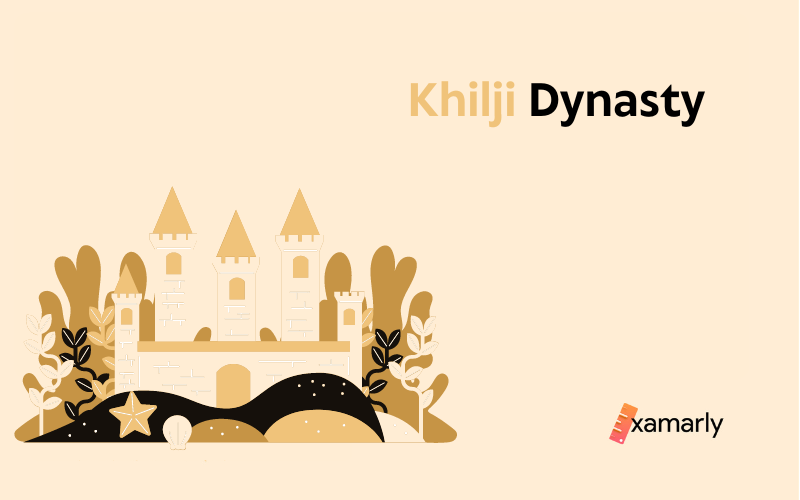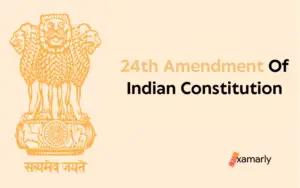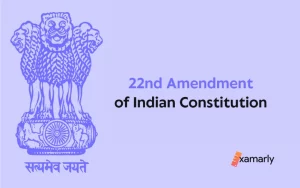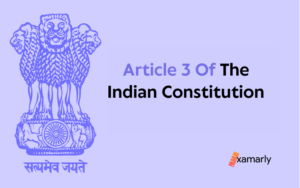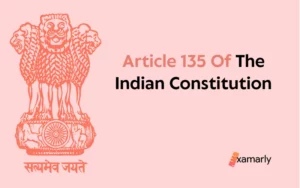The Khilji or Khalji dynasty is one of the 5 powerful Delhi Sultanate dynasties that ruled huge swaths of the Indian subcontinent from 1206 to 1526. Chronologically, the Khilji dynasty comes second, preceded by the Mamluk dynasty, and succeeded by the Tughlaq dynasty. The dynasty reigned for almost a decade, specifically between 1290 and 1320. Coming into power, the dynasty developed a power shift from Turkic nobles to Afghans.
Two events are remarked as the achievement of this dynasty – successful conquests and expansion of Islamic state power to present-day South India and repeated repulsion of Mongol invasion. This article will take you through some important rulers of the dynasty and how their rule brought forth political, cultural, and artistic changes to Indian history.
- About Khilji Dynasty
- Khilji Dynasty Map
- Khilji Dynasty Rulers
- Jalaluddin Khilji (1290-1296)
- Alauddin Khilji (1296-1316)
- Shihabuddin Omar (1316)
- Qutbuddin Mubarak Shah (1316-1320)
- Khusrau Khan (1320)
- Administration Of Khilji Dynasty
- Khilji Dynasty Architecture
- Coins Of Khilji Dynasty
- The Decline Of Khilji Dynasty
- Conclusion
- FAQs
About Khilji Dynasty
Khilji Dynasty Origin
Although belonging to a Turkish tribe, the Khalji was culturally more in tune with Central Asian cultures. They had Afghan and Turkish origin or a mixed Turkish-Afghan origin. The ancestors of this Turk-Afghan Khalji clan, the Khalaj, are believed to be Turkish people from Central Asia who resettled to Afghanistan. They went on to become vassals for the Mamluk dynasty.
Founder
In his efforts to maintain stability, Ghiyasuddin Balban (one of the last Mamluk rulers) overthrew the Forty. However, this indirectly harmed the Turkish integrity of the nobility. So, the kingdom ended up being subject to many political instabilities from the Indo-Muslim people thereby leading to assassinations. The Mamluk authorities were gradually killed one after the other. Further, Jalal ud din Firuz Khalji assassinated the last Sultan of the Mamluk dynasty. This put an end to the Mamluk dynasty. Further, Jalaluddin rose above all the opposition from Turkish nobles. Thus, in 1290, he ascended to the throne of Delhi. He became the founder and the first ruler of the Khilji dynasty.
Khilji Dynasty Map
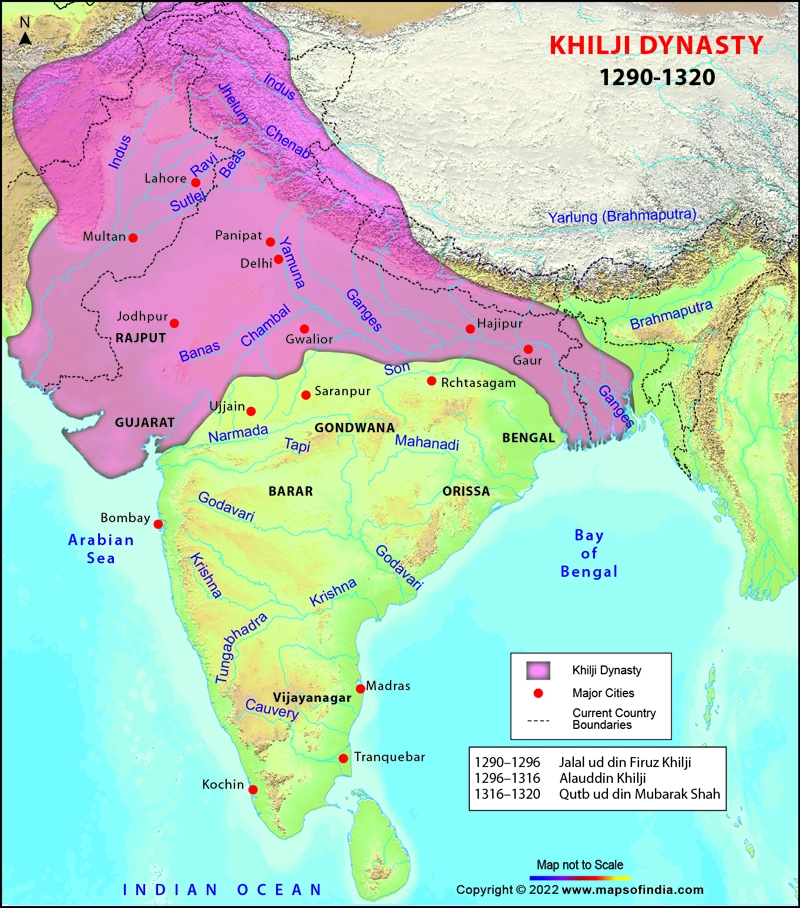
Khilji Dynasty Rulers
Given below are basic details of the five known rulers of Khilji dynasty.
Jalaluddin Khilji (1290-1296)
Jalal-ud-din Khalji or Jalaluddin Khilji was the first Sultan of the Khalji dynasty. Born Firuz, he was initially a Mamluk official. Under Sultan Muizzuddin Qaiqabad, he grew into a more prominent position. Just after the paralysis of Sultan Qaiqabad, an organization of nobles recognized the sick Sultan’s infant child Shamsuddin Kayumars as the new Sultan. They tried to murder Jalaluddin. Interestingly, Jalaluddin went on to kill them and took over as regent. Subsequently, he emerged as the new Sultan.
Jalaluddin Khalji repelled a Mongol invasion and as a Sultan, he made way for Mongols to settle in India once they converted to Islam. Several Turkish nobles saw him as an incompetent monarch and attempted unsuccessfully to depose him at various times. With the exception of a dervish Sidi Maula, who was executed for allegedly plotting to dethrone him, he meted out lenient sentences to the insurgents. Jalal-ud-din was assassinated by his nephew Ali Gurshasp, who ascended to the throne as Alauddin Khalji.
Candidates can learn more about Jalaluddin Khilji, by visiting the linked article.
Alauddin Khilji (1296-1316)
Alauddin Khalji was the Khilji dynasty’s second ruler. Alauddin was his predecessor Jalaluddin’s nephew and son-in-law. When Jalaluddin became Sultan of Delhi after deposing the Mamluks, he appointed Alauddin as Amir-i-Tuzuk (equivalent to a master of ceremonies). After putting down a rebellion against Jalaluddin, Alauddin was appointed governor of Kara in 1291 and governor of Awadh in 1296, following a profitable raid on Bhilsa. Alauddin raided and looted Devagiri in 1296 as an effective resistance against Jalaluddin. After killing Jalaluddin, he consolidated his power in Delhi.
Alauddin implemented many administrative changes concerning revenues, price controls, and society. He also successfully repelled several Mongol incursions into India. Over the next few years, Alauddin skillfully thwarted Mongol invasions from the Chagatai Khanate at Delhi, Amroha, Jaran-Manjur, Sivistan, and Kili. His forces defeated the Mongols near the Ravi riverbank in 1306.
Military commanders such as Zafar Khan, Ulugh Khan, and Malik Kafur led his army successfully against the Mongols. Gujarat, Jaisalmer, Ranthambore, Chittor, Malwa, Siwana, and Jalore were all conquered by Alauddin.
Alauddin was ill in his final years and had to rely on Malik Kafur to handle the administration. He died of illness in 1316. Alauddin Khilji’s tomb is located at the Qutb complex in Mehrauli, Delhi. His dynasty was characterized by a passion for ruling over the world.
To learn more about Alauddin Khilji, check out the linked article.
Shihabuddin Omar (1316)
The third Sultan of the Khalji Dynasty and the fourteenth Sultan of the Delhi Sultanate was Shihab-ud-din Omar. He ascended the throne in 1316 when his father died. He was supported by Alauddin’s slave general, Malik Kafur. The following year, he was overthrown by Qutb-ud-din Mubarak.
Shihabuddin’s participation in governance was limited during Kafur’s brief regency to his appearance in a daily court ceremony. Kafur used to send Shihabuddin to his mother and hold individual meetings with officials to decide and issue orders.
To learn more about Shihabuddin Omar, explore the linked article.
Qutbuddin Mubarak Shah (1316-1320)
Qutbuddin Mubarak Shah of the Khalji Dynasty was the third king of the dynasty. Qutb-ud-din Mubarak Shah was Alauddin Khalji’s son. Following Alauddin’s death, Malik Kafur imprisoned Mubarak Shah. His younger brother Shihabuddin Omar was instigated as a puppet monarch.
Mubarak Shah took over as regent following Malik Kafur’s assassination. He soon blinded his brother and seized power. Following his accession to the throne, he implemented policies like repealing his father’s high taxes and penalties and freeing prisoners. He brought down an uprising in Gujarat, recaptured Devagiri, and successfully besieged Warangal to retrieve a tribute. Khusrau Khan plotted his assassination and went on to usurp the throne.
To learn more about Qutbuddin Mubarak Shah, visit the linked article.
Khusrau Khan (1320)
In 1320, Khusrau Khan ruled over Delhi for about two months. He was born in Gujarat. During the capture of Malwa in 1305, Khusrau Khan was seized by Alauddin Khalji’s army. Since being brought to Delhi as a slave, he converted to Islam. He also became Mubarak Shah’s (Alauddin’s son’s) homosexual partner. Mubarak Shah bestowed the title “Khusrau Khan” on him after ascending to the throne in 1316.
Khusraw Khan led a triumphant campaign to reestablish Delhi’s authority over Devagiri in 1317. The following year, his army captured Warangal. He commanded a group of Baradus and discontented nobles in the slaying of Mubarak Shah and subsequently took over the throne as Nasiruddin.
Candidates can learn more about Khusrau Khan by clicking on the linked article.
Administration Of Khilji Dynasty
The Khilji dynasty’s administration was carefully controlled by the king. Khilji sultans, especially Alauddin Khilji, changed spending practices. This was to account for his treasury and also to stock up for wars. He raised the tax on agriculture output or agriculture products from 20 percent to 50 percent. During Allauddin Khilji’s reign, there were kinds of taxes that the Non-Muslims had to pay. These were – jizya or poll tax, kharaj or land tax, Kari or house tax, chari or field duty.
During this period, Alauddin Khalji implemented numerous administrative, agriculture, market, military, and revenue reforms.
- He developed a scientific method for calculating land revenue and measuring land.
- Alauddin Khilji pioneered the practice of paying warriors in cash. He maintained a sizable and powerful standing army.
- The sale and consumption of alcoholic beverages and intoxicants have been made illegal in Delhi.
- He established a complex network for data collection on black marketing and hoarding in order to keep critical commodities affordable.
To learn more about Delhi Sultanate Administration, check out the linked article.
Khilji Dynasty Architecture
The architecture of the Khilji dynasty was an incredible blend of intellectual and creative knowledge. The Qutb Minar, the Taj Mahal, the Jama Masjid, and the Alai Darwaza, the southern entrance hall to the courtyard, are great examples of Khalji architecture. The Alai Darwaza, which is the southern entrance hall to the courtyard, is considered a unique piece of the Delhi Sultanate monument due to its shape, walling techniques, and surface decoration.
One of the most impressive examples of Khilji dynasty art and architectural achievements can be found in the Siri Fort. This magnificent structure was constructed to protect the country from Mongol invasions. Inside the Siri Fort, one can find the living quarters of the Khaljis as well as many other buildings. These buildings include the 1,000-pillar palace of Ala-ud-din Khalji and Hazar Sutun. These structures are the last surviving examples of the architecture of the Khilji dynasty.
Despite his illiteracy, Alauddin was a generous patron of art and learning. His patronage was enjoyed by both Amir Khusrau and Mir Hasan Dehlvi.
To learn about the Art And Architecture Of Delhi Sultanate, check out the linked article.
Coins Of Khilji Dynasty
The coins of this dynasty had a multi-facet design and the name of the Khilji was etched on the reverse. During this period, the value of the ‘tankah’ (silver coin) was approximately sixty ganis. The coins were produced at the Mint in Delhi. The Khilji dynasty introduced a new system of coinage. Their coins were made from copper, silver, and white metal, and were issued in units of one rupee.
Under Khalji dynasty, the Khilji rulers made a new change in the currency. This dynasty’s five rulers introduced new patterns into the currency system. In almost every way, Jalaluddin Firoz followed Balban’s coins. Conquests in South India had enriched Alauddin Khilji’s treasury. During his reign, he issued a large number of coins. He and Qutbuddin Mubarak Shah, his successor, issued heavy-weight gold and silver ‘tankah’ and coins. According to historical evidence, Alauddin Khilji altered the pattern of coin inscriptions. The Khalifa name on the front of the coming was removed.
The Decline Of Khilji Dynasty
The Khalji dynasty fell into a never-ending pit of coups, assassinations, and political turbulence after the death of Allauddin Khalji. Later, Malik Kafur became Sultan. But he was assassinated in months due to a lack of support from the amirs. Malik Kafur’s death was followed by the reign and death of three other rulers. The amirs made Shihab-ud-din Omar the sultan. Qutb, the regent and Sultan’s brother, murdered his brother and went on to proclaim himself Sultan. He made Ghazi Malik the army commander as he felt that this would help him gain favor and support from the Amirs. Others were given the option of various offices or death.
Mubarak Shah was assassinated in 1320 by one of his generals, Khusraw Khan. Ghazi Malik was persuaded by Amirs to direct a coup. Ghazi Malik’s coup obliged and beheaded Khusraw Khan. Ghazi Malik changed his name to Ghiyath al-Din Tughluq. Hereby, Ghiyasuddin Tughlaq became the Tughluq dynasty’s first ruler.
Conclusion
The Khalji dynasty ruled over large regions of the Indian subcontinent between the years 1290 and 1320. Being the second dynasty in line, the dynasty helped strengthen the roots of the Delhi Sultanate mostly by subduing the Moghol invasion. They also expanded their reign into South India. To read up on each of these rulers, log on to our website and enjoy in-depth learning of Indian history.
FAQs
What Was The Capital Of Khilji Dynasty?
Delhi was the capital of Khalji Dynasty from where the Delhi Sultanate was governed.
Who Was The Founder Of The Khilji Dynasty?
The KhIlji dynasty was founded by Jalal-ud-din Khalji.
Who Was The First Ruler Of Khilji Dynasty?
Jalal-ud-din Firuz Khalji was the first ruler of Khilji Dynasty.
Write About The Khilji Dynasty Time Period.
The timeline of Khilji Dynasty was 1290-1320. They ruled from the late 13th century to the early 14th century.
The Famous Sultan Of Khilji Dynasty Was Whom?
Alauddin Khalji
Who Was The Last Ruler of Khilji Dynasty?
Khusrau Khan
How Many Kings Are There In Khilji Dynasty?
Five kings are there to rule the Sultanate of Delhi under its second dynasty – Jalaluddin Khalji, Alauddin Khalji, Shihab-ud-din Omar, Qutbuddin Mubarak Shah, and Khusrau Khan.


